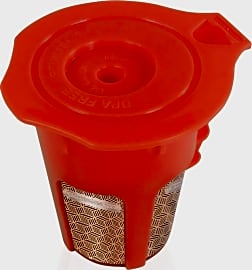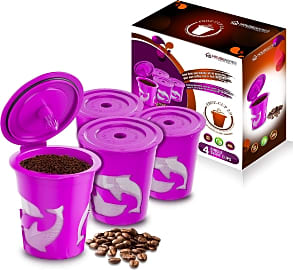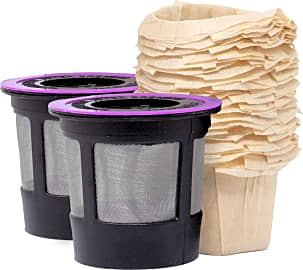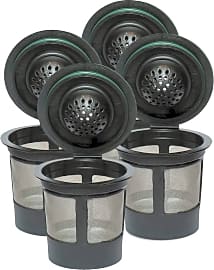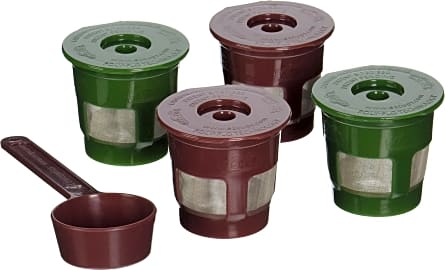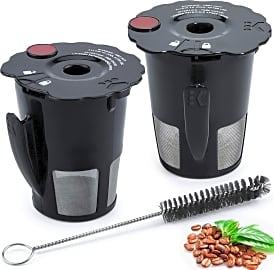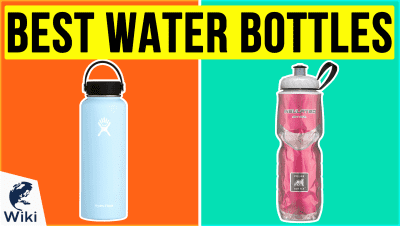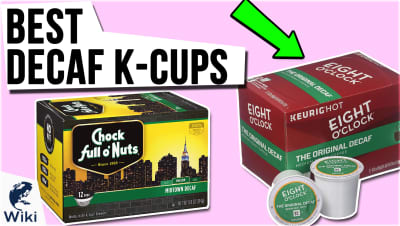The 10 Best Reusable K-Cups

This wiki has been updated 38 times since it was first published in January of 2017. These reusable K-Cups make it simple to brew your favorite ground coffee in your machine, saving you money and helping the environment. And because you fill them yourself, you have freedom when choosing your coffee beans. We've rounded up a variety of options both for single-cup servings and carafes, including models that are compatible with 1.0, 2.0, and Plus series Keurigs. When users buy our independently chosen editorial selections, we may earn commissions to help fund the Wiki.
Editor's Notes
November 01, 2020:
We removed Fill N Save Elite, Youngever Universal, and Di Oro Premium due to availability concerns and replaced them with the Sikawai 119367, GoodCups Rainbow, and iPartsPlusMore Universal Fit respectively. Similar to the Youngever Universal, the Sikawai 119367 comes in a variety of colors making it a great option if you make a lot of different beverages in your pod coffee maker, or live in a house with other coffee drinkers. The different colors make it easy to designate colors to either specific beverages, or certain people in your household. The iPartsPlusMore Universal Fit is a good addition because it is dishwasher safe, making deep-cleaning a cinch.
September 26, 2019:
If you love the convenience that comes with a Keurig brewer, but you don’t love the thought of adding to a landfill every time you drink a cup of coffee, these Reusable K Cups can save you from that dilemma. Plus, they allow you to enjoy the flavor of freshly ground beans that standard K Cups cannot provide you with.
Joining the selection in this update is the iPartsPlusMore 2 Pack which, unlike many others, comes with a set of unbleached, biodegradable paper filters. While some coffee drinkers don’t mind sediment from the filter making its way into their drink (where it tends to settle on the bottom, anyway), others consider it a nuisance. These filters will keep any grounds from leeching into your beverage, ensuring a smooth morning cup of joe. The pods that come with this set are made of durable plastic that’s free of BPA, as well as long-lasting micromesh filters.
Leaving the list today is the Di Oro MaxBrew, which essentially was a duplicate of the smaller pod that’s part of the Di Oro Premium set, which currently fills our number two spot.
October 18, 2018:
Replaced outdated models and expanded offerings to include pods that are compatible with a wider range of machines. Also added carafe options that can be used to brew several cups at a time.
A Brief History Of Single-Serve Coffee
After the war, freeze-dried instant coffee hit the shelves, and in 1970, the automatic drip maker was released, courtesy of Mr. Coffee.
The story of human history before coffee is likely one that some scribe meant to write down, if only he'd been able to find the energy. However, we're not worried about the whole history of coffee right now. We're just talking about the single-serve version.
The invention of single-serve coffee didn't start with the K-cup. Instant coffee was invented in France in 1881, using something called a "dry hot-air process." What that means is a mystery, but people kept tinkering with it until 1938, when the Nescafé brand was launched.
This soluble powder coffee was incredibly popular during WWII, as it was easy for troops to make when they were on the front lines, and it kept them energized and alert while on guard duty.
After the war, freeze-dried instant coffee hit the shelves, and in 1970, the automatic drip maker was released, courtesy of Mr. Coffee. Eventually, the company released models small enough to make a single cup rather than a whole pot, although the process was still pretty time-consuming.
While the single-serving drip pots became popular in offices across the United States and Europe, it was the release of the Keurig coffee maker and its special dispensary system, the K-cup, in 1998 that truly set the market on fire.
The company came along at a fortuitous time, as the rapid expansion of Starbucks had already familiarized people with the idea of paying for a single cup of coffee. The idea of getting just one cup when you need it — without having to walk down the street to Starbucks, or up the street to the other Starbucks — was immediately popular.
What made the Keurig so ingenious is that the company exclusively owned both the product and the delivery system. If you wanted easy, single-serve coffee, you used K-cups. If you used K-cups, you needed a Keurig.
However, that exclusivity didn't last long, as several other companies — including Starbucks — began to release their own versions of both the K-cup and the Keurig machine. Still, Keurig continues to dominate the market.
It certainly looks like the single-serve coffee maker is here to stay, so the days of brewing (and wasting) an entire pot just to pour one cup are gone.
If you ask us, though, anyone who drinks only one cup of coffee a day simply lacks hustle.
Benefits Of A Reusable K-Cup
One of the biggest downsides to using Keurigs with disposable K-cups is that they're more expensive than other types of coffee (also, they're bad for the environment, but more on that later).
Most can be put in the dishwasher when you're done with them, so you don't have to worry about clogs.
That's the primary advantage of a reusable cup. Like having your own water bottle, it stops you from needing to constantly buy new units. All you have to buy is the coffee, saving you a bundle on containers.
They also free you up to use your own grounds — provided you have a grinder, of course. Instead of being limited to whatever flavors the big coffee companies put out, you can use your own beans, making them fantastic for snobs and aficionados.
Reusable cups are usually better-designed than the disposal ones, as well, allowing for superior water dispersion. That helps create a delicious brew, time after time. Most can be put in the dishwasher when you're done with them, so you don't have to worry about clogs.
If you're addicted to your Keurig, there's no reason not to invest in your own reusable K-cup — unless you like throwing away money in addition to coffee pods.
Just How Bad Are K-Cups For The Environment, Anyway?
While Keurigs continue to grow in popularity, the backlash against them seems to be growing just as fast. The primary complaint? That they're terrible for the environment — and that's not entirely wrong, given that the disposable K-cups are neither recyclable nor biodegradable.
Even worse, the number of K-cups that are already clogging up our landfills could stretch around the planet at least 10 times, if for some reason we wanted to confuse aliens by encircling the Earth with K-cups. When you include the fact that about a quarter of homes in America now feature a single-use coffee maker, it certainly seems unlikely that that number will dwindle anytime soon.
That they're terrible for the environment — and that's not entirely wrong, given that the disposable K-cups are neither recyclable nor biodegradable.
Manufacturers haven't been deaf to the outcry, however. Keurig has committed to making their pods recyclable by 2020, but that's not enough for many critics.
The problem is that even these recyclable K-cups still aren't biodegradable or compostable, and they use a tremendous amount of plastic. Since only about 34 percent of all trash today is recycled, making the cups recyclable will only slow down the rate at which they fill our dumps, rather than stop it altogether.
Not everyone is sold on the fact that these pods are a menace, however. The things are small, and as such, they represent a tiny percentage of all the trash being dumped in our landfills. Also, coffee's biggest environmental impact is still found in its brewing process, which uses quite a bit of water and electricity — especially if the machine doesn't power down when not in use.
As always, the truth probably lies somewhere in the middle. Will K-cups single-handedly destroy the planet? No, probably not. But that's no excuse to create a bunch of needless waste, especially since a superior alternative to making single-serve coffee is already at hand.


